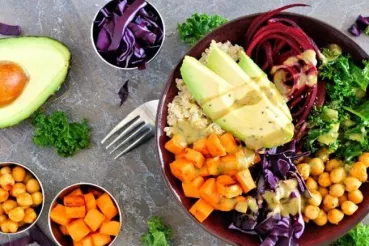There's been a lot of talk about making cities, buildings and cars more "green." But how about making your diet greener by enjoying a heaping helping of leafy green vegetables?
Leafy greens include arugula, romaine lettuce, mesclun mix (or "spring mix"), spinach, kale, collard, turnip and mustard greens, watercress, chard, broccoli rabe and Chinese broccoli.
With so many options, it's easy to make these healthful and tasty veggies a more prominent part of your plate.
Packing a nutritious punch
"Green, leafy vegetables are a must-have since they give you a bigger 'bang for your buck': They are nutrient-dense but not energy-dense (higher in calories), so you get all the benefits of vitamins, minerals and fiber without all the calories," says dietitian Jennifer Ventrelle, MS, RDN, CPT.
How nutritious are they? For starters, they're high in antioxidants such as vitamin A and vitamin C, and rich in vitamin K, potassium and iron. They also serve as a great source of fiber.
"These nutrients provide many benefits, such as boosting the immune system during those cold winter months and keeping the heart healthy," Ventrelle says. "They may even work toward cancer prevention."
An added bonus: The natural fiber in leafy greens can help you feel satisfied longer because the nutrients remain in the stomach longer with the fiber. That satisfied feeling can also lead to decreased overall caloric consumption and, potentially, weight loss.
Brain-boosting benefits?
And a study suggests that leafy greens may feed your brain as well.
According to the study, which was published online in the December 2017 issue of Neurology, eating one serving of leafy green vegetables a day may aid in preserving memory and thinking skills as a person grows older.
"Adding a daily serving of green leafy vegetables to your diet may be a simple way to help promote brain health," says a nutritionist. "There continues to be sharp increases in the percentage of people with dementia as the oldest age groups continue to grow in number. Effective strategies to prevent dementia are critically needed."
The study results suggest that people who ate one serving of green, leafy vegetables had a slower rate of decline on tests of memory and thinking skills than people who rarely or never ate them. The study results also suggest that older adults who ate at least one serving of leafy green vegetables showed an equivalent of being 11 years younger cognitively.
"The study results do not prove that eating green, leafy vegetables slows brain aging, but it does show an association," says a nutritionist. "The study cannot rule out other possible reasons for the link."
The results must be confirmed by other investigators in different populations and through randomized trials to establish that cause-and-effect relationship. But in the meantime, the other proven health benefits of leafy greens make them an essential part of any healthy diet.
The more veggies, the better
Ideally, vegetables should make up the majority of your plate. A good rule of thumb is for half of the plate to be vegetables, with the other half left for equal parts protein and healthy carbohydrates (such as whole grains).
Make half your serving of vegetables leafy greens, such as spinach or a simple salad, and half other types of vegetables, such as grilled peppers, asparagus, peas, green beans or squash. It's also a good idea to start your meal by eating vegetables so you'll have less of an appetite for rich, sugary foods.
But be careful how you prepare those veggies, Ventrelle warns. "One thing to be aware of when boiling vegetables is that the vitamins can leach out into the water," she says. "So whenever possible, eat vegetables raw or lightly steamed rather than cooking them immersed in water."
Other advice for healthier preparations:
- If you do sauté vegetables, choose olive oil and try not to use much more than a tablespoon
- Rather than drowning vegetables in butter or heavy sauces, cut back on the fat and make them delicious by dressing them with dried or fresh herbs, spices, balsamic vinegar or a squeeze of fresh lemon juice
- Try grating the rind of a citrus fruit, such as lime or orange, into your recipe for some extra zest.
Green, leafy vegetables give you a bigger 'bang for your buck': They are nutrient-dense but not energy-dense (higher in calories).
It's easy being green
Here are some ideas for incorporating leafy greens into your daily menu:
- For an appetizer everyone will love, stuff button mushroom caps with sautéed spinach and top with a light sprinkling of Parmesan cheese.
- Start off dinner with a fresh romaine or mesclun salad tossed with fresh, crisp veggies like carrots, bell peppers, radishes and cucumbers. For a change of pace, try pairing peppery arugula with sweet figs or cherry tomatoes.
- Instead of serving heavy, cream-based soups, whip up a refreshing watercress soup. It will add both color — a vibrant green — and nutrients to your meal.
- Make stuffing, rice and pasta dishes greener by adding kale, broccoli rabe or mustard greens.
- Serve up a side of spinach, kale or collard greens. Sauté the greens in olive or sunflower oil and add light seasoning (pepper, garlic, red pepper flakes, lemon, etc.).
- Fresh spinach, kale and chard also make great salads, if you're looking for an alternative to lettuce. These flavorful, vitamin-rich greens pair well with a myriad of nuts, fruits and other veggies. Just be sure to keep the dressing light.
- Add finely chopped broccoli rabe or spinach to Arborio rice to create a hearty risotto the whole family will love.
- For a refreshing start to your day or mid-afternoon energy booster, make a smoothie by blending spinach or kale with your favorite fresh or frozen whole fruits.
New life for leftovers
Leafy greens are also great for jazzing up your leftovers. Try topping your sandwiches with a handful of fresh spinach or arugula, mix your favorite greens into a casserole, or use broccoli rabe or Chinese broccoli to create a flavorful stir-fry.
The possibilities — and recipes — are endless.
"If you aren't already eating a lot of leafy green vegetables, it's never too late to start," says Ventrelle. "You may be so surprised by how satisfied you feel; you won't have as much room to over-indulge on those not-so-great-for-you rich, sugary foods."




